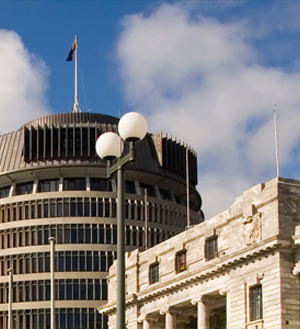On 4 November 2025, the government revealed a number of proposed changes to the Climate Change Response Act 2002 (CCRA), including to processes for changing industrial allocations of New Zealand Units (NZUs), as part of enhancing “efficiency and effectiveness”. It also released a new framework aimed at supporting recognition of non-forestry carbon removal projects.
But what do these announcements mean for stakeholders?
With next year’s election on the horizon, climate change seems likely to take an increasingly prominent role on the policy agenda. Against that background, recent Cabinet papers reveal the government’s intention to legislate change with the introduction of a new Climate Change Response (Efficiency and Effectiveness) Amendment Bill in early 2026.1 This Bill will make various changes to the New Zealand Emissions Trading Scheme (NZ ETS), including delinking unit volumes and price control regulations from New Zealand’s international climate obligations and reducing the mechanisms for changes to industrial allocations of NZUs.
These changes are in addition to the Climate Change Response (2050 Target and Other Matters) Amendment Bill, which was announced last month to reset New Zealand’s domestic targets for biogenic methane emissions, and which the Cabinet papers confirm will be passed before the end of this year.
In this article, we provide an overview of the newly-announced changes which will be of interest to those involved with the NZ ETS, particularly those receiving an industrial allocation. They will also be of note for parties with interests in carbon removals.
Summary
The proposed legislation will:
Make changes to improve efficiency and effectiveness, including:
- Moving the process for reviewing NZ ETS price control and unit volume settings from an annual process to a biennial process.
- Adding the ability for the Environmental Protection Authority (EPA) to approve extensions for certain NZ ETS-related filings where participants have experienced significant disruption.
- Allowing the EPA to waive certain penalties incurred due to circumstances beyond a participant’s control.
- Simplifying the processes for amending Emissions Reduction Plans and National Adaptation Plans.
- Removing certain specific consultation requirements in respect of emissions budgets and other documents.
Delink price control settings from New Zealand’s international obligations. The Minister would no longer need to consider New Zealand’s nationally determined contribution when determining auction limits and price control settings.
Remove the ability to review eligibility for industrial allocations and allocative baselines for emissions-intensive, trade-exposed businesses receiving NZUs.
In addition, the government has released a high-level assessment framework for non-forestry carbon removals. This framework sets out initial guidance on matters interested parties might consider where they are interested in participating either in voluntary markets or, potentially, in the NZ ETS or contributing to New Zealand’s Nationally Determined Contribution (NDC).
Increasing ‘efficiency and effectiveness’
The Cabinet papers reveal a clear concern that the CCRA as it stands is overly complex and prescriptive.2 To address this, the government is proposing to amend the Act’s purpose to refer to “efficient and effective policies” through the Climate Change Response (Efficiency and Effectiveness) Amendment Bill.3
The proposed bill will also make changes to the processes for review of NZ ETS price control and unit volumes settings. At present, these require an annual process which starts with the Climate Change Commission reviewing and reporting on proposed changes to the settings for the next five years. The government then considers that report and makes decisions on changes to the settings. Under the proposed changes, this would move to a biennial process.
There are a number of other changes included in the proposed bill in the interests of improving efficiency. Specifically, it would:4
- Remove requirements that the Climate Change Commission provide advice on the direction of policy for each Emissions Reduction Plan, with the government instead able to request that advice if it wishes.
- Simplify the requirements for Emissions Reduction Plans, while also allowing the Minister to make amendments to those plans and supporting policies without consultation (providing the Minister considers the emissions impact and the impact on iwi and Māori).
- Allow a National Adaptation Plan to be amended at any time subject to the Minister considering the implications for addressing the most significant risks as well as the impact on iwi and Māori.
- Remove the specific obligations on the Climate Change Commission to consult with the public on emissions budgets and reduction plans, and instead rely on its general obligation to engage with persons it considers relevant.
- Remove the obligation on the Minister to consider the results of public consultation when setting an emissions budget.
- Allow the Minister to consider any auction results that triggered price controls since the last amendment to the NZ ETS settings to be considered as part of reviewing changes to the NZ ETS settings for the next two years. At present, the triggering of price controls can only be considered if it occurs within the same year as the amendment.
In addition, the government is proposing changes to increase the effectiveness of the NZ ETS, including by:5
- Allowing the EPA to approve certain extensions for emissions returns and related applications where participants are affected by a significant disruption.
- Allowing the EPA to grant extensions of up to three years to timeframes for re-establishing forest land where affected by a disruption.
- Making minor changes to the arrangements around giving a transmission of interest notice.
Allowing the EPA to waive the penalty for failure to surrender/repay units by the due date if it is satisfied it occurred through no fault of the person. - Making other adjustments to the penalties provisions, including to ensure that a penalty can be imposed on parties who incorrectly report emissions, removals or units when there were none. The formula currently used in such circumstances results in these parties being given a zero-dollar penalty.
The government expects that these changes will “reduce costs to government and business,” reduce regulation and support economic growth and investment by reducing uncertainty.6
Delinking NZ ETS unit volumes, price controls from international obligations
In addition to its domestic targets, New Zealand has international emissions reduction targets, as set out in its NDC under the Paris Agreement. Under the CCRA as it currently stands, when the Minister sets ETS auction limits and price control settings, they must be satisfied that those limits and settings are in accordance with the relevant NDC (as well as domestic targets).7
The government is proposing to remove that requirement, so the Minister would no longer need to consider accordance with the NDC as part of determining auction limits and price control settings. This is because, in the government’s view, New Zealand’s first NDC is intended to be met through purchasing offshore units to offset New Zealand’s domestic emissions. The NZ ETS, as a domestic policy instrument, should instead be aligned with domestic targets rather than international goals.8 In addition, the Cabinet papers reveal a concern that retaining the link between the NZ ETS and international targets risks undermining confidence as, if New Zealand struggles to secure offshore units, participants may expect ETS auction volumes to be reduced to address the shortfall.9 This concern is particularly relevant since international carbon markets under the Paris Agreement are still developing.
The government has also signalled that it will remove the requirement for the Minister of Climate Change to set emissions budgets in light of the global goal to limit warming to 1.5°C. This is on the basis that the 2050 target is New Zealand’s contribution to this goal and separate consideration is therefore unnecessary.10
Some reviews of industrial allocations to go, phase outs remain
The CCRA provides for allocations of free NZUs to emissions-intensive, trade-exposed firms, with a view to enabling them to better compete in global markets. The level of assistance reduces over time via the phase out provisions, encouraging such businesses to reduce their emissions before being exposed to the full force of the ETS. The CCRA also permits the Minister to review a firm’s eligibility for an industrial allocation at any time, while its allocative baseline (which impacts its entitlement to NZUs) may be reviewed after five years and must be reviewed after 10 years.11
The Government considers that such reviews risk disincentivising investment in emissions reductions. This is because, where firms invest to significantly reduce their emissions, a review will likely reduce their industrial allocation, and therefore the free NZUs that they receive.
It proposes to remove the ability to review allocative baselines and eligibility for industrial allocations for participating firms. Instead, the incentive to reduce emissions will come by way of the phase out provisions which will remain largely in their current form.12 The government also proposes to amend provisions around phase out reviews so they are no longer tied to emissions budget periods but cannot be changed more than once every five years.
The proposed bill will also make some changes to the Minister’s ability to require copies of electricity contracts, again with the aim of increasing certainty. In addition, the Cabinet papers note that the Minister has directed officials to undertake further work to inform the future of industrial allocations, including because the proposed changes do not fully eliminate the distortion caused by the current settings or address concerns about the scheme’s long-term suitability.13 Firms operating in this area should therefore watch this space.
Incentivising carbon removals
At present, the principal way to earn ETS credits for removal of carbon from the atmosphere is through forestry – there is little recognition of other forms of carbon removal.
The government hopes to see other forms of carbon removal recognised, including to enable farmers and other landowners to offset their own emissions. To that end, it intends to amend the CCRA to add “carbon removal activities” as an activity for which a person may choose to participate in the NZ ETS. While this will not automatically mean that such activities are recognised and rewarded within the NZ ETS, it is a first step to simplify that process.14
Alongside its Cabinet papers, the government has also released an Assessment Framework for Carbon Removals. This framework seeks to support those individuals and organisations who want to see their carbon removals recognised, either by the government via the NZ ETS or as part of New Zealand’s NDC, or else in voluntary markets. While the government does not regulate these voluntary markets, it has committed to ensuring high integrity, including through work on a New Zealand voluntary nature credits market.
The Assessment Framework is presently at a high level only. However, it may provide a useful starting point for parties considering how best to go about getting their non-forestry removals formally recognised. At present the process includes:
The Assessment Framework

Other changes
In addition to the above, the government’s announcement revealed a number of other changes:
- Importing CO2 will become a “mandatory activity” under the ETS. This is to align the position for those who import CO2 with the position for domestic producers.
- The government will remove the goal of government organisations being carbon neutral by 2050 (on the basis that this is out-of-step with expectations on the wider economy).
- The requirements for Climate Implications of Policy Assessments for new legislation will be amended, so that officials are only required to assess a policy’s climate implications where it is likely to impact 0.25 per cent of the total permitted emissions of any notified emission budget period or to have a material impact on actions under an emissions reduction plan or the achievement of an emissions budget. This is in contrast to the position at present where an assessment is required if the objective is to decrease emissions, the impact is likely to be 0.5 million tonnes of CO2 equivalent within the first 10 years (or above three million tonnes within 30 years for forestry proposals).
The proposed changes therefore touch on many areas of the NZ ETS and associated processes. We will keep you updated of any changes as the proposed legislation passes through the House.
If you have any questions about this article, please get in touch with the contacts listed or your usual Bell Gully adviser.
1. Cabinet minute “Climate Change Response Amendment Bill: Policy Decisions” ECO-25-MIN-0151 at [14] and [15]. A complete set of the Cabinet materials proactively released is available here: Policy decisions for a Climate Change Response Amendment Bill | Ministry for the Environment.
2. Cabinet paper “Policy decisions for a Climate Change Response Amendment Bill” (22 September 2025) at [8].
5. Cabinet paper Appendix 4 “Proposed changes to the CCRA to improve the effectiveness of the NZ ETS”.
6. Cabinet paper “Policy decisions for a Climate Change Response Amendment Bill” (22 September 2025) at [4].
8. Cabinet paper at [11] and [13].
9. Cabinet paper Appendix 5 “Regulatory Impact Statement: Proposal to remove NDC accordance requirement for NZ ETS settings” (22 September 2025) at [9].
Disclaimer: This publication is necessarily brief and general in nature. You should seek professional advice before taking any action in relation to the matters dealt with in this publication.











